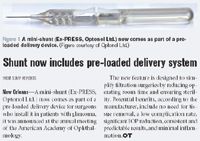Article
Mini-glaucoma shunt associated with fewer postop complications compared with trabeculectomy
Author(s):
A proprietary miniature glaucoma device implanted under a partial-thickness scleral flap is safe and predictable compared with trabeculectomy.

Key Points

The device is a small, stainless steel tube that shunts aqueous fluid into the subconjunctival space. In this way, the flow of aqueous is very similar to that achieved with trabeculectomy.

"This is an important part of the procedure," Dr. Netland said.
Although the refinement slowed the flow of aqueous fluid slightly, it provided added security by helping to improve the success rate of the procedure and reducing the rates of conjunctival erosion and hypotony. An additional step that some surgeons take is to use flap sutures and laser suture lysis to reduce the risk of hypotony further, according to Dr. Netland.
Another change from the initial procedure was abandoning the use of a viscoelastic to maintain IOP during the immediate postoperative period. The viscoelastic generally was not useful in the long term because too much variability of the IOP existed. Use of the partial-thickness scleral flap and sutures are keys to the improvement of the procedure, Dr. Netland said.
Since introducing the use of a scleral flap to the procedure, three studies have reported a decrease in conjunctival erosion, with rates reported ranging from 0% to 11%. Those studies were conducted by Peter J. Maris Jr., MD, and colleagues (Journal of Glaucoma 2007;16:14-19); Elie Dahan, MMed Ophth, and Trevor Carmichael, MD, PhD (Journal of Glaucoma 2005;14:98-102); and Carlo Traverso, MD, and associates (British Journal of Ophthalmology 2005;89:425-429).
Dr. Netland and colleagues conducted a study of 319 eyes to assess the most common complication associated with use of the device, namely, obstruction of the tube. That complication was corrected easily with a YAG laser, he said.
"We still see some complications associated with the device, but they are quite uncommon," he said. "We found that the biocompatibility of the device is excellent, and the complications are minimal, particularly since the procedure was refined."
The investigators reported their findings at the most recent Association for Research in Vision and Ophthalmology annual meeting.
Newsletter
Don’t miss out—get Ophthalmology Times updates on the latest clinical advancements and expert interviews, straight to your inbox.




